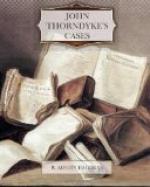“In the first place there was the condition of the hand. When a person, at the moment of death, grasps any object firmly, there is set up a condition known as cadaveric spasm. The muscular contraction passes immediately into rigor mortis, or death-stiffening, and the object remains grasped by the dead hand until the rigidity passes off. In this case the hand was perfectly rigid, but it did not grasp the hair at all. The little tress lay in the palm quite loosely and the hand was only partially closed. Obviously the hair had been placed in it after death. The other two facts had reference to the condition of the hair itself. Now, when a lock of hair is torn from the head, it is evident that all the roots will be found at the same end of the lock. But in the present instance this was not the case; the lock of hair which lay in the dead woman’s hand had roots at both ends, and so could not have been torn from the head of the murderer. But the third fact that I observed was still more conclusive. The hairs of which that little tress was composed had not been pulled out at all. They had fallen out spontaneously. They were, in fact, shed hairs—probably combings. Let me explain the difference. When a hair is shed naturally, it drops out of the little tube in the skin called the root sheath, having been pushed out by the young hair growing up underneath; the root end of such a shed hair shows nothing but a small bulbous enlargement—the root bulb. But when a hair is forcibly pulled out, its root drags out the root sheath with it, and this can be plainly seen as a glistening mass on the end of the hair. If Miriam Goldstein will pull out a hair and pass it to me, I will show you the great difference between hair which is pulled out and hair which is shed.”
[Illustration: A, SHED HAIRS SHOWING THE NAKED BULB, MAGNIFIED 32 DIAMETERS.
B, HAIRS PLUCKED FROM SCALP, SHOWING THE ADHERENT ROOT-SHEATHS, MAGNIFIED 20 DIAMETERS.]
The unfortunate Miriam needed no pressing. In a twinkling she had tweaked out a dozen hairs, which a constable handed across to Thorndyke, by whom they were at once fixed in a paper-clip. A second clip being produced from the box, half a dozen hairs taken from the tress which had been found in the dead woman’s hand were fixed in it. Then Thorndyke handed the two clips, together with a lens, to the coroner.
“Remarkable!” exclaimed the latter, “and most conclusive.” He passed the objects on to the foreman, and there was an interval of silence while the jury examined them with breathless interest and much facial contortion.
“The next question,” resumed Thorndyke, “was, Whence did the murderer obtain these hairs? I assumed that they had been taken from Miriam Goldstein’s hair-brush; but the sergeant’s evidence makes it pretty clear that they were obtained from the very bag of combings from which he took a sample for comparison.”
“I think, Doctor,” remarked the coroner, “you have disposed of the hair clue pretty completely. May I ask if you found anything that might throw any light on the identity of the murderer?”




